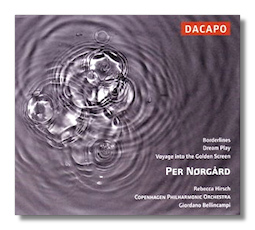
The Internet's Premier Classical Music Source
Related Links
- Latest Reviews
- More Reviews
-
By Composer
-
Collections
DVD & Blu-ray
Books
Concert Reviews
Articles/Interviews
Software
Audio
Search Amazon
Recommended Links
Site News
 CD Review
CD Review
Per Nørgård

- Borderlines (Violin Concerto #2)
- Dream Play
- Voyage into the Golden Screen
Rebecca Hirsh, violin
Copenhagen Philharmonic Orchestra/Giordano Bellincampi
Da capo 8.226014 DDD 52:07
Over the course of his career as a composer, the Dane Per Nørgård (b. 1932) has experimented with a variety of compositional techniques, including a form of serialism he calls "the infinity series," collage, and Ligeti-like micropolyphony. Composed between 1968 (Voyage) and 2002 (Borderlines), the three works on this CD capture this composer's varying moods and interests. Dream Play and Borderlines are receiving their first recordings with this release.
Voyage into the Golden Screen is a landmark in Nørgård's output because this is the first work in which the infinity series plays a central and audible role. There are two movements, and each movement's infinity series writhes around a single pitch or pair of pitches, engendering its own restless continuation. (Think, for example, of a supercomputer churning out pi to an infinite number of digits.) Simultaneously, the series may be repeated at half or even at one-quarter the tempo, sometimes in its mirror-image. (For example, a rising whole tone interval is mirrored by a falling whole tone interval.) In the words of the composer, writing about the second movement, "That this does not result in tonal chaos is solely due to the properties of the infinity series – for they ensure that all notes meet on unisons!" The first movement is mysterious and plaintive. Nørgård's analogy is of a fjord "where a score of sailing ships are moving in the same direction, but at slightly different speeds." The second movement turns in the gentle wind as if it were a mobile.
Dream Play was written in 1975 and revised five years later. It continues Nørgård's work with infinity series, but with more flexibility and expression. The atmosphere is warm with humanism, and the flavor is almost exotic. ("As if one is for example at an enchanted afternoon party with an Indian prince," writes Nørgård.)
Borderlines is much darker than its discmates. This work seems to be a commentary on modern political realities. The orchestra shifts unpredictably between a more-or-less regular diatonic or chromatic scale, and microtonal writing, putting the soloist in the difficult position of having to cope with the "borders" between one type of orchestral playing and another. "In Borderlines," writes annotator Ivan Hansen, "Nørgård is preoccupied with interference, fluctuation, and ambivalence." As a result, this concerto is much more prickly than the other two works. English violinist Rebecca Hirsh was this concerto's première soloist, and she copes with its uncertainties and ambiguities very well.
Bellincampi has been the principal conductor of the Copenhagen Philharmonic since 1997. (He is an Italian, but he has lived in Denmark since 1976.) The performances seem definitive, and the engineering is on a par with that of the other great Scandinavian labels – BIS and Ondine.
Copyright © 2004, Raymond Tuttle


















